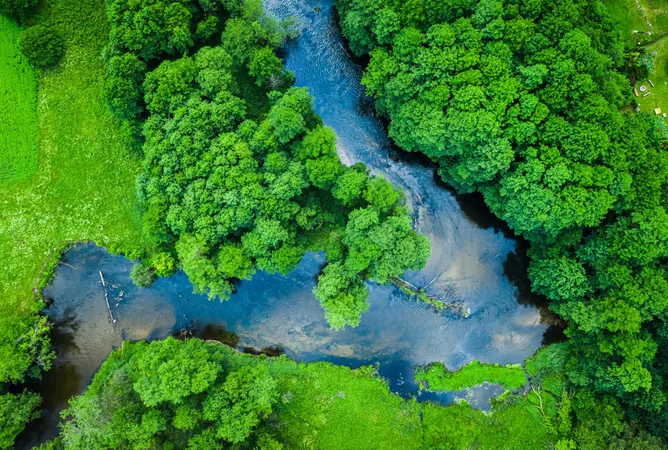
Unveiling the Mighty Microbes: How Tiny Life Forms Are Essential for River Health
2024-11-21
Author: Sarah
Introduction
Rivers and streams are not just mere water channels; they are crucial lifelines that traverse diverse landscapes from serene headwaters to expansive oceans. These waterways are vital for human and environmental health, agriculture, and energy production, supplying about two-thirds of the drinking water in the United States.
However, while large water bodies like oceans and lakes have been extensively studied, the microbiology of rivers has been largely overlooked—until now. A groundbreaking study led by scientists from Colorado State University (CSU) has made significant strides by cataloging the microorganisms that inhabit rivers across 90% of the continental U.S., shedding light on their roles and functions.
Published in the prestigious journal *Nature*, the findings reveal that river microbes are key players in regulating nutrient flow, enhancing water quality, and maintaining environmental health. This research opens a new chapter in the field of microbiome studies, emphasizing the need to understand these tiny organisms' vital functions.
The Importance of River Microbes
The study highlights the critical role microbes play in sustaining the health of rivers. These microorganisms are referred to as “master orchestrators of nutrient and energy flows,” crucial in determining water quality amidst current and future ecological challenges. The researchers discovered that river microbes interact with various contaminants, including antibiotics, fertilizers, microplastics, and disinfection byproducts. Remarkably, these microbes have the ability to degrade microplastics into smaller carbon compounds, though they also exhibit increased levels of antibiotic resistance genes near wastewater treatment plants, indicating human impacts on these ecosystems.
As CSU research professor Mikayla Borton, the lead author of the study, observed, “People used to think of rivers almost just as pipes, a way to move water from one place to another. But rivers are much more than that; they perform all kinds of activities, and those activities can be predicted.”
Understanding River Ecosystems as Integrated Units
The research also provides support for the River Continuum Concept, a long-standing theory that emphasizes the interconnectedness of river ecosystems where upstream activities significantly impact downstream health. The team discovered that microbes share this interconnectedness. Co-author Matt Ross, an associate professor at CSU, noted, "This work aligns quite well with these old theories, reinforcing the importance of understanding rivers as integrated systems."
A Collaborative Approach to Science
To map river microorganisms, the researchers analyzed over 2,000 microbial genomes collected from about 100 rivers across North America, leveraging the participation of local volunteers through a program coordinated by the Pacific Northwest National Laboratory (PNNL). This collaborative effort exemplifies how community engagement can enrich scientific research.
Kelly Wrighton, a professor at CSU and co-author of the study, explained, “When we look at how the land around a river is managed, we can see how certain anthropogenic contaminants or chemicals are processed through the microbes in their DNA.” This relationship suggests a broader signal in the microbiome that reflects our land management practices.
Microbial Indicators of Ecosystem Health
Microbiome science is an emerging field with immense potential for monitoring environmental health. River microbes could serve as indicators of ecosystem changes, much like the proverbial canary in a coal mine. As Wrighton expressed, “Our hope is that this information will lead to new diagnostics that indicate the health of a river.”
The study identified six core microorganisms active in all sampled rivers, which relied on light as an energy source. Their consistent presence underscores the robustness of the science preceding this groundbreaking work.
A Path to Addressing Global Challenges
This research not only uncovers essential insights into river microbes but also showcases the powerful potential of large-scale participatory science. The collaboration began in 2018 when Wrighton joined forces with James Stegen, a PNNL earth scientist leading a global river sampling initiative, resulting in a project that has the potential to tackle pressing issues like climate change.
The project’s achievements include creating a searchable, user-friendly database of river microbiome data, which can serve as a valuable resource for scientists and policymakers alike. Borton expressed excitement about this new infrastructure, hoping it inspires broader ecological models that consider microbial processes.
A New Era in Environmental Research
This study is a turning point in environmental science, revealing the intricate dynamics of river microbiomes and redefining our understanding of rivers as vibrant, interconnected ecosystems. As Stegen put it, “This is new frontier kind of stuff; we’re really opening the doors to a deeply under-characterized part of the Earth. It's gratifying to create something that can benefit our communities and the environment.”
From enhancing ecosystem modeling to addressing global climate challenges, the insights derived from this research have the potential to inform innovative solutions to some of the world's most critical environmental problems. As we continue to explore the hidden world of river microbes, we may uncover new strategies to protect and sustain our vital waterways for future generations.

 Brasil (PT)
Brasil (PT)
 Canada (EN)
Canada (EN)
 Chile (ES)
Chile (ES)
 España (ES)
España (ES)
 France (FR)
France (FR)
 Hong Kong (EN)
Hong Kong (EN)
 Italia (IT)
Italia (IT)
 日本 (JA)
日本 (JA)
 Magyarország (HU)
Magyarország (HU)
 Norge (NO)
Norge (NO)
 Polska (PL)
Polska (PL)
 Schweiz (DE)
Schweiz (DE)
 Singapore (EN)
Singapore (EN)
 Sverige (SV)
Sverige (SV)
 Suomi (FI)
Suomi (FI)
 Türkiye (TR)
Türkiye (TR)